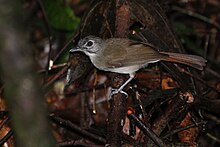
The Indian scimitar babbler is an Old World babbler. It is found in peninsular India in a range of forest habitats. They are most often detected by their distinctive calls which include an antiphonal duet by a pair of birds. They are often hard to see as they forage through dense vegetation. The long curved yellow, scimitar-shaped bills give them their name. It has been treated in the past as subspecies of the white-browed scimitar babbler which is found along the Himalayas but now separated into two species, the peninsular Indian species and the Sri Lanka scimitar babbler.

The white-crested laughingthrush is a member of the family Leiothrichidae. It is a highly social and vocal bird found in forest and scrub from the Himalayan foothills to Southeast Asia.
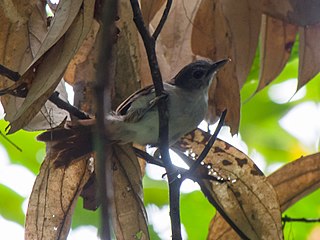
The sooty-capped babbler is a member of the family Pellorneidae. It occurs in Malaysia, Indonesia, Brunei, Thailand, and Singapore.

The pale-billed woodpecker is a species of bird in subfamily Picinae of the woodpecker family Picidae. It is found from Mexico to Panama.

The stripe-headed sparrow is an American sparrow which breeds from Pacific coastal south-western Mexico, including the transverse ranges, Cordillera Neovolcanica to Pacific coastal northern Costa Rica.

The Bonin white-eye or meguro (メグロ) is a small songbird endemic to the Bonin Islands of Japan. It is the only species in the genus Apalopteron. Its taxonomic affinities were a long-standing mystery and it has been placed with the bulbuls, babblers and more recently with the honeyeaters, during which it was known as the Bonin honeyeater. Since 1995 it is known to be a white-eye in the family Zosteropidae, that is closely related to the golden white-eye of the Marianas Islands.

The rail-babbler or Malaysian rail-babbler is a strange, rail-like, brown and pied ground-living bird. It is the only species in the genus Eupetes and family Eupetidae. It lives on the floor of primary forests in the Malay Peninsula and Sumatra, as well as Borneo. It is distantly related to African crow-like birds. Its population has greatly decreased because much of the lowland primary forest has been cut, and secondary forests usually have too dense a bottom vegetation or do not offer enough shade to be favourable for the species. However, it is locally still common in logged forest or on hill-forest on slopes, and probably not in immediate danger of extinction. The species is poorly known and rarely seen, in no small part due to its shyness.
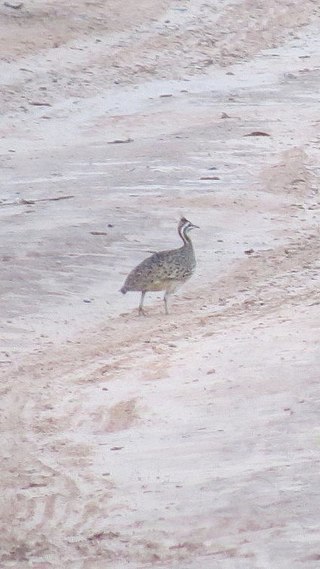
The quebracho crested tinamou is a species of tinamou found in dry forest habitats in Paraguay and northern Argentina in South America.
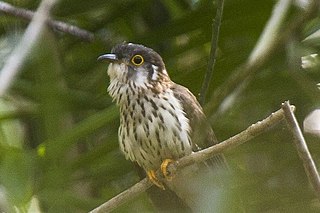
The moustached hawk-cuckoo is a species of cuckoo in the family Cuculidae. It is found in Brunei, Indonesia, Laos, Malaysia, Myanmar, and Thailand. Its natural habitat is evergreen and secondary forests. Threatened by habitat loss, it has been assessed as a near-threatened species.
The flame-templed babbler is a species of bird of the family Zosteropidae, in the genus Dasycrotapha. It is one of the most remarkable and distinctive birds with its complex head markings with orange crown tufts, black ears and yellow beak and face. It is endemic to the Philippines, where it is found on the islands of Panay and Negros. Its natural habitat is tropical moist lowland forest. It is threatened by habitat loss. Along with the Negros striped babbler, it is one of the two babbler species extremely sought after by birdwatchers on Negros.

The whiskered flowerpecker is a species of bird in the family Dicaeidae. It is endemic to the island of Mindanao in the Philippines.

The ashy-headed babbler is a species of passerine bird in the ground babbler family Pellorneidae. The species is also known as the ashy-crowned babbler. The species is closely related to the short-tailed babbler. The two species are sometimes treated as the same species but differ in their calls. The species is monotypic, meaning it has no subspecies.

The Palawan striped babbler is a species of bird in the family Zosteropidae. It is endemic to the Philippines, where it is only found in Palawan.

The Luzon striped babbler is a species of bird in the family Zosteropidae. It is endemic to the Philippines, where it is only found in northern Luzon and in Bataan.

The white-throated woodcreeper is a species of bird in the subfamily Dendrocolaptinae of the ovenbird family Furnariidae. It is found in Argentina, Brazil, and Paraguay.
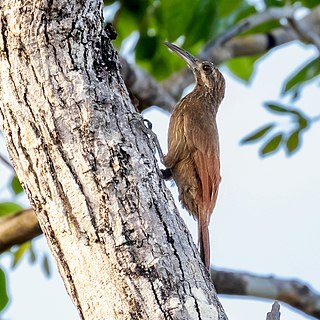
The moustached woodcreeper is a Vulnerable species of bird in the subfamily Dendrocolaptinae of the ovenbird family Furnariidae. It is endemic to Brazil.

The great slaty woodpecker is a species of bird in the family Picidae. It is found across the Indian Subcontinent and Southeast Asia. A unique and basically unmistakable bird, it is the largest known species of woodpecker.

The Bicol ground warbler is a species of passerine bird in the family Locustellidae. It is endemic to the island of Luzon in the Philippines, where it is found in the southern parts of the island. Along with its other conspecifics, such as the Cordillera ground warbler and the Sierra Madre ground warbler, it is one of the most elusive birds in the country. Its natural habitat is tropical moist lowland forest. It is threatened by habitat loss.

The chestnut-hooded laughingthrush is a species of bird in the laughingthrush family Leiothrichidae endemic to Borneo. Described by the British ornithologist Richard Bowdler Sharpe as a distinct species in 1879, it was subsequently considered a subspecies of the chestnut-capped laughingthrush until 2007, when it was again raised to species status by the ornithologists Nigel Collar and Craig Robson. It is 22–24 cm (8.7–9.4 in) long, with a chestnut brown head and chin, with grey feathering on the top of the head. The upperparts and the side of the neck are slaty-grey, with a long white wing patch. The throat, breast, and upper belly are dull yellowish-brown, with purer grey flanks and a reddish-brown vent, lower belly, and thighs. It has a yellow half eye-ring behind and below the eye, while the tail has a blackish tip. Both sexes look similar, while juveniles are duller than adults.

The Luzon boobook or Luzon hawk-owl is a species of owl in the family Strigidae. It is endemic to the Philippines where it lives in forests. It is a brown and white mottled bird and males and females look much alike.
